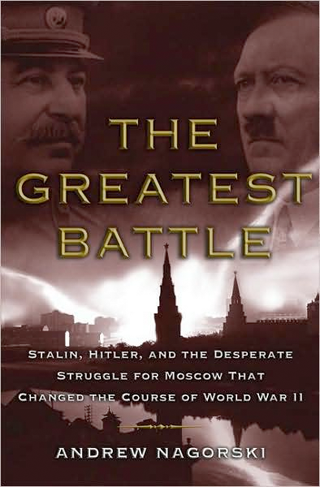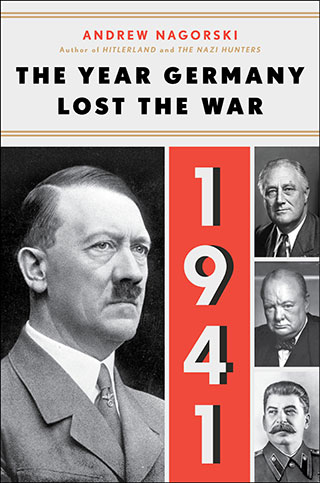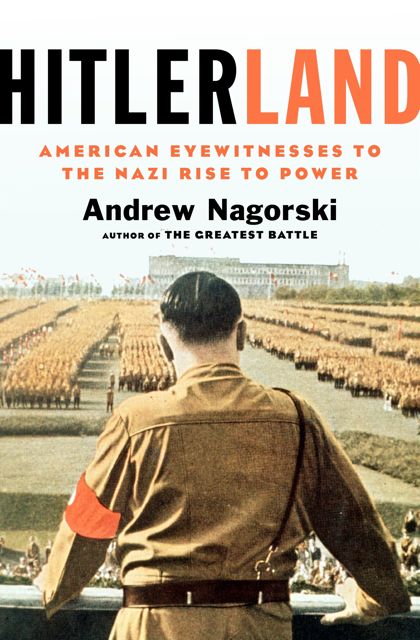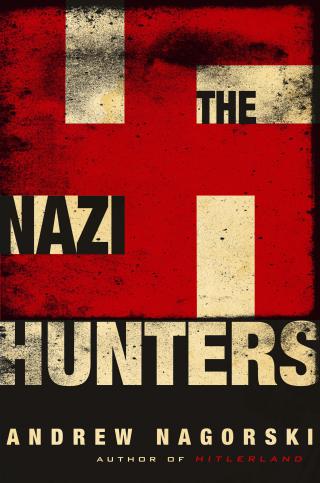Otto and Elise Hampel were improbable German resisters. By all accounts, the working-class, middle-aged couple accepted Hitler’s New Order up until 1940. Then, during the invasion of France, Elise’s brother was killed—and something snapped in them. The pair began writing postcards denouncing the Nazi regime and calling on Germans to engage in civil disobedience and sabotage.
“Hitler’s war is the worker’s death!” one of them proclaimed. They managed to drop the postcards in public places all over the German capital for two years. Although almost all of these subversive missives were immediately turned into the authorities by the terrified Berliners who picked them up, the Gestapo and the police frantically searched for the perpetrators, assuming they were dealing with a much larger conspiracy. In October 1942 the Hampels were finally arrested and, after their forced confessions, tried, convicted, and sent to the guillotine.
There’s nothing to indicate that this seemingly ordinary couple’s crusade won anyone over to their cause, and their actions never attracted the kind of postwar attention that other tales of resistance did. Much better known are the stories of the White Rose, the Munich students who wrote incomparably more elegant leaflets against the regime before they were arrested and executed in 1943; the defiance of Dietrich Bonhoeffer and other church figures; the Red Orchestra, as the Soviet-linked, often highly placed espionage rings were called; and of course, the failed plot to assassinate Hitler in 1944. The White Rose and the Hitler plot, in particular, have inspired countless books and films.
But the Hampels’ story wasn’t completely forgotten. It would serve as inspiration for Hans Fallada (1893-1947), the immensely popular German novelist of the 1930s who refused to join the Nazi party but also refused to flee his homeland. As Fallada saw it, that left him no choice but to make numerous compromises with Hitler’s regime so that he could keep writing: “I do not like grand gestures, being slaughtered before the tyrant’s throne, senselessly, to the benefit of no one,” he declared later.
When the war ended, Johannes Becher, a German Communist writer who had returned from exile in Moscow and Tashkent, used his position as a rising cultural apparatchik in the Soviet occupation zone to reach out to Fallada. He arranged housing and writing assignments for the ailing writer, who had struggled with alcoholism and morphine addiction while trying to survive the war and Hitler. Most significantly, Becher supplied him with documents from the Gestapo file about the Hampels’ case, suggesting that this might serve as the subject of his next novel.
Fallada took the message to heart. His final novel, Every Man Dies Alone, written in an astounding 24-day spurt, is based loosely on the Hampels’ story. And shortly before its publication in 1947, Fallada succumbed to his assorted addictions and ailments at age 53. His last work was praised, but didn’t achieve the huge sales or psychological impact of his prewar hits. That was hardly surprising: Germany was just beginning to recover from the devastation of 12 years of National Socialism and six years of war; it was too early for an exhausted, shattered nation to focus on a novel that confronts the issues of resistance and fear.
The recent decision by Melville House to translate Every Man Dies Alone into English for the first time, while reissuing two of Fallada’s earlier novels in paperback, should go a long way towards elevating this book to the place it deserves in world, and not just German, literature. If Fallada’s early popularity sometimes raised suspicions that he was a bit of a lightweight, his final book demonstrates the opposite. It’s unquestionably his most powerful work: Primo Levi described it as “the greatest book ever written about German resistance to the Nazis.” That’s an accurate judgment and not just a routine blurb, but it fails to reflect the full scope of Fallada’s accomplishment. By chronicling the actions of a couple who did exactly what he and most Germans refused to do, Fallada raises the larger question of the meaning of “grand gestures” in the face of any tyranny.
Hans Fallada’s real name was Rudolf Ditzen, and his complicated personal story allowed him to understand the lives of his varied cast of fictional characters. Aside from a prolific novelist, he was many things: a mental patient, a prisoner, a farm worker, a journalist, an alcoholic, a drug addict, and, at the end of World War II when the Red Army occupied his small town, briefly a district mayor. Although he incurred the Nazis’ wrath on several occasions, he never was a member of any resistance group. He tried to keep his distance from a regime he clearly loathed, but he bent to its will when he felt he had to, while battling his inner demons.
In 1911, when he was 18, Ditzen and a fellow student staged a duel, which was supposed to serve as a respectable cover for a suicide pact. Ditzen fatally wounded his friend, whose shot missed him. Ditzen then shot himself with his friend’s gun, but survived. Charged with murder, he was declared unfit to stand trial and was committed to his first stint in a mental institution, followed by drugs, treatment centers, and subsequent work on farms and a series of other jobs. He was twice caught embezzling to feed his drug addiction, leading to his first jail sentences.
Ditzen’s father was a retired justice of the Supreme Court, and his son must have been a continuing source of embarrassment. When he began to make good on his ambition of becoming a writer—the publisher Ernst Rowohlt printed his first novel, Young Goedeschal, in 1920—his father was unnerved by its autobiographical story and suggested he use a pseudonym. Rudolf chose Hans Fallada, both names associated with the Grimm brothers. In their story “Hans in Luck,” the title character is a simple fellow who convinces himself he’s lucky even when he’s swindled again and again. In “The Goose Girl,” a horse named Falada (one “l”) bears witness to the treachery of a maid who usurped the identity of the princess she served. Frightened that the horse may reveal all, the maid orders it beheaded—but the truth ultimately comes out when the horse’s head is nailed on a city gate and starts to talk.
In his more mature novels, Fallada infuses his characters and plots with many of the same themes: naïveté and the search for identity and truth, despite the brutality of the world that his characters inhabit. Little Man, What Now?—his 1932 novel that has been reissued in paperback—was a huge bestseller in Germany, and an international hit translated into more than 20 languages. It was made into separate films in Germany and the United States. It tells the story of a young couple whose struggle to survive and start a family plays out against the backdrop of the Depression. Johannes Pinneberg loses one job and then another after marrying his pregnant girlfriend Lämmchen (the diminutive for “lamb” in German). Pinneberg believes that he will be able to provide for his small family even when everything looks relentlessly grim. But it’s Lämmchen who is the anchor of the book: She is determined, tender, and willing to put up with all hardships.
Fallada’s literary style is often held up as an example of Neue Sachlichkeit, the movement for more literal, realistic representation in the arts. The Manchester Guardian ascribed the success of Little Man, What Now? to its “unsentimental realism,” and much of its appeal is, indeed, its unsparing description of the life of two individuals caught up in an economic crisis they can hardly understand. At one point a policeman singles out the shabbily dressed Pinneberg in a crowd of window shoppers, ordering him to move on. The unemployed ex-salesman suddenly understands “that he was on the outside now, that he didn’t belong here any more, and that it was perfectly correct to chase him away. ... Poverty is not just misery, poverty is an offence, poverty is a stain, poverty is suspect.”
But realism isn’t enough to explain why the novel captured the popular imagination of readers around the world. Nor is the sympathetic portrayal of Lämmchen. The narrator saves the couple by departing from harsh realism when it suits his purpose: Thus, Fallada makes sure that whenever it looks like the couple will sink too far, a near-miraculous intervention keeps them afloat. For all the talk of realism, the narrator is susceptible to sentimentalism, which adds to the book’s appeal. There is always hope, the narrator is saying: The Guardian didn’t have it completely right.
The narrator also sets the political context. Lämmchen comes from a working-class family and her “heart was with the Communists.” But the couple isn’t much concerned with politics; they simply want a roof over their heads and enough to eat. Fallada dismissively mentions a coworker of Johannes who is a Nazi, and injects the occasional rumination about social injustice.
How could one really laugh in a world where captains of industry are allowed to line their own pockets and make hundreds of mistakes, whereas the little people who had always done their best were humiliated and squashed?
Major literary figures such as Hermann Hesse, Carl Zuckmayer, and Lion Feuchtwanger, all of whom would become anti-Nazi voices outside of Germany, were enthusiastic about Fallada’s bestseller. The Nazis were put off by its negative portrayal of the party activist and by Fallada’s empathy for Jews, but they also applauded its harsh spotlight on life in Weimar Germany.
Like Pinneberg, Hans Fallada wanted to live his life and largely ignore the political battles swirling around him. The enormous success of Little Man, What Now? provided him with enough money to leave Berlin and purchase a small farm in the village of Carwitz, 50 miles north of the capital. He lived there with his wife Anna, who—like Lämmchen, the character modeled after her—came from a working-class background and exuded a commonsense approach to life that offered him more stability than he ever had. Martha Dodd, the daughter of William Dodd, the American ambassador in Berlin during 1933-37, was curious to meet Fallada and paid him a visit.
"He was a stockily built man with blondish hair and charming, genial features; his wife plump, blonde, serene, with a peasant face. They had two children, a young, bright-faced boy of four and an infant in arms. Their life seemed to be built around their family and their farm. He was isolated from life and happy in his isolation."
Dodd was in the process of becoming a fervent anti-fascist, a path that would lead to close contacts with Soviet diplomats and charges that she spied for the Kremlin. (In 1953 she fled the United States and spent most of the rest of her life in Prague.) She was naturally scornful of a prominent writer like Fallada for his decision to disengage as much as possible from the political scene: “I got the impression that he was not and could not be a Nazi—what artist is?” she noted. “This withdrawal from life was Hans Fallada’s tragic solution to the problems that might have been troubling his peace. It was a temptation to which he had completely succumbed. And the impression of defeatism he gave us was saddening.”
Yet Fallada wasn’t so much withdrawing from life as frantically trying to keep writing, always conscious that the Nazis could silence him at any time. While his social criticism and sympathetic characters were tolerated because they were situated in an earlier era, the Völkischer Beobachter complained that “he was never one of us.” At times, Fallada went to some lengths to ingratiate himself with Germany’s rulers: In the foreword to his novel Once a Jailbird (1934), he appeared to endorse the changes in the justice system under the Nazis, and he wrote a final section of Iron Gustav (1938) at Joseph Goebbels’s insistence, transforming the main character into a Nazi sympathizer.
While defending such actions, he was clearly not proud of them, and considered emigrating on more than one occasion. He almost took up an offer from his British publisher to emigrate in late 1938, but reconsidered. He couldn’t imagine living in exile, but was also finding it increasingly difficult to continue his life in Germany, even in the relative isolation of Carwitz. His drinking was out of control. He and Anna divorced in July 1944, and on August 28, he pulled a gun on her. In the ensuing scuffle Anna took his gun and hit him over the head. According to a court document, he had drunk a dozen bottles of wine in the two days leading up to this incident, and as a result was confined to a psychiatric hospital for three-and-a-half months.
It was there that Fallada wrote The Drinker.He had always written with near-manic speed, as if he couldn’t get the words out fast enough, and the notations in his manuscript indicate that he wrote this novel in two weeks. Writing in the first person and making no attempt to disguise the parallels to his life, he launches right into his descent into alcoholism. Starting with the opening line—“Of course I have not always been a drunkard”—he quickly adds, “But then the time came when things began to go wrong with me.” The opening paragraph also includes this revealing sentence: “Worst of all, the feeling gradually grew on me that even my wife was turning away from me.” This is typical Fallada, plunging right into his stories, sweeping the reader into their tumultuous flow from the very beginning.
Erwin Sommer is the main character, a merchant whose drinking leads to the loss of everything: his job, money, wife. Like the author, Sommer threatens to kill his wife after consuming vast amounts of alcohol, an incident that hardly registers with him till he is incarcerated. But unlike Fallada, Sommer is too far gone to convince anyone he can be freed. Here Fallada tells a story of self-destruction, viewed through the booze-soaked mind of Sommer. He can see what’s happening, and is powerless to do anything about it. As Sommer is led from prison to the mental institution where he will spend the rest of his days, he passes a sign for his old store: “Erwin Sommer: Market Produce, Wholesale and Retail.”
And led along by a little chain, a suitcase in his free hand, this same Erwin Sommer went by, living yet dead for all that; traces of his life still remained—for how much longer?
It’s as searing a portrayal of an alcoholic as exists in modern literature. Of course, the book could have been set anywhere, since Sommer is in a private hell that doesn’t offer or need any references to war or Nazis. But there’s a natural tendency to interpret his portrayal of the brutal world of the asylum as a commentary on his larger surroundings, where so many were led away, feeling similarly powerless.
The Drinker had no chance of publication under the Nazis, and would only be published in West Germany in 1950, three years after Fallada’s death. Emerging from the asylum, Fallada took up with Ursula Losch, a 24-year-old widow who shared his weaknesses for alcohol and morphine. They married in Berlin in February 1945 and a bombing raid broke up their party afterwards. The couple quickly fled the capital, returning to her country cottage. When the war ended, Soviet authorities briefly appointed Fallada mayor of the district around Carwitz, but he wasn’t capable of dealing with the chaos of the early occupation. He once again sought refuge in morphine, and Ursula tried to kill herself. After they were both hospitalized they returned to Berlin, where Fallada would meet Johannes Becher and become acquainted with the Gestapo file of Otto and Elise Hampel.
Politics is front and center in Every Man Dies Alone. Written right after the war, it is set in Berlin and populated by a lengthy and varied cast of characters who demonstrate the full range of human behavior during the terror of Nazi wartime rule: everything from sadistic brutality and desperate opportunism to glimmers of compassion and defiant courage. While Fallada breathes life into all of his characters, he is especially fascinated with those who opt for resistance, knowing the likely outcome.
At the center are Otto and Anna Quangel, who receive news of the death of their son in the invasion of France. Otto is a dour foreman in a furniture factory, a stickler for enforcing the rules, and usually so silent that most people barely notice him. Anna has learned to live with his apparent lack of emotion, and keeps her feelings in check as well. But when the letter arrives explaining that their son has died “a hero’s death for Führer and Fatherland,” she lashes out at Otto: “Lies, all a pack of lies! But that’s what you get from your wretched war, you and that Führer of yours!”
Otto is stunned by this first outburst in their long marriage. He protests that he voted for Hitler only once, as she did, and can’t fathom what has happened. Taking on the painful task of informing his son’s girlfriend Trudel, he’s confronted by another surprise: When he admits his feeling of helplessness, the young woman confides that she’s joined a secret resistance cell in her factory. Even if they are vastly outnumbered by the Nazis and their followers, she explains, “the main thing is that we remain different from them, that we never allow ourselves to be made into them, or start thinking as they do.” And she quotes one of the organizers of the cell:
He said we are like good seeds in a field of weeds. If it wasn’t for the good seeds, the whole field would be nothing but weeds. And the good seeds can spread their influence.
Like Pinneberg, Hans Fallada wanted to live his life and largely ignore the political battles swirling around him. The enormous success of Little Man, What Now? provided him with enough money to leave Berlin and purchase a small farm in the village of Carwitz, 50 miles north of the capital. He lived there with his wife Anna, who—like Lämmchen, the character modeled after her—came from a working-class background and exuded a commonsense approach to life that offered him more stability than he ever had. Martha Dodd, the daughter of William Dodd, the American ambassador in Berlin during 1933-37, was curious to meet Fallada and paid him a visit.
He was a stockily built man with blondish hair and charming, genial features; his wife plump, blonde, serene, with a peasant face. They had two children, a young, bright-faced boy of four and an infant in arms. Their life seemed to be built around their family and their farm. He was isolated from life and happy in his isolation.
Dodd was in the process of becoming a fervent anti-fascist, a path that would lead to close contacts with Soviet diplomats and charges that she spied for the Kremlin. (In 1953 she fled the United States and spent most of the rest of her life in Prague.) She was naturally scornful of a prominent writer like Fallada for his decision to disengage as much as possible from the political scene: “I got the impression that he was not and could not be a Nazi—what artist is?” she noted. “This withdrawal from life was Hans Fallada’s tragic solution to the problems that might have been troubling his peace. It was a temptation to which he had completely succumbed. And the impression of defeatism he gave us was saddening.”
Yet Fallada wasn’t so much withdrawing from life as frantically trying to keep writing, always conscious that the Nazis could silence him at any time. While his social criticism and sympathetic characters were tolerated because they were situated in an earlier era, the Völkischer Beobachter complained that “he was never one of us.” At times, Fallada went to some lengths to ingratiate himself with Germany’s rulers: In the foreword to his novel Once a Jailbird (1934), he appeared to endorse the changes in the justice system under the Nazis, and he wrote a final section of Iron Gustav (1938) at Joseph Goebbels’s insistence, transforming the main character into a Nazi sympathizer.
While defending such actions, he was clearly not proud of them, and considered emigrating on more than one occasion. He almost took up an offer from his British publisher to emigrate in late 1938, but reconsidered. He couldn’t imagine living in exile, but was also finding it increasingly difficult to continue his life in Germany, even in the relative isolation of Carwitz. His drinking was out of control. He and Anna divorced in July 1944, and on August 28, he pulled a gun on her. In the ensuing scuffle Anna took his gun and hit him over the head. According to a court document, he had drunk a dozen bottles of wine in the two days leading up to this incident, and as a result was confined to a psychiatric hospital for three-and-a-half months.
It was there that Fallada wrote The Drinker. He had always written with near-manic speed, as if he couldn’t get the words out fast enough, and the notations in his manuscript indicate that he wrote this novel in two weeks. Writing in the first person and making no attempt to disguise the parallels to his life, he launches right into his descent into alcoholism. Starting with the opening line—“Of course I have not always been a drunkard”—he quickly adds, “But then the time came when things began to go wrong with me.” The opening paragraph also includes this revealing sentence: “Worst of all, the feeling gradually grew on me that even my wife was turning away from me.” This is typical Fallada, plunging right into his stories, sweeping the reader into their tumultuous flow from the very beginning.
Erwin Sommer is the main character, a merchant whose drinking leads to the loss of everything: his job, money, wife. Like the author, Sommer threatens to kill his wife after consuming vast amounts of alcohol, an incident that hardly registers with him till he is incarcerated. But unlike Fallada, Sommer is too far gone to convince anyone he can be freed. Here Fallada tells a story of self-destruction, viewed through the booze-soaked mind of Sommer. He can see what’s happening, and is powerless to do anything about it. As Sommer is led from prison to the mental institution where he will spend the rest of his days, he passes a sign for his old store: “Erwin Sommer: Market Produce, Wholesale and Retail.”
And led along by a little chain, a suitcase in his free hand, this same Erwin Sommer went by, living yet dead for all that; traces of his life still remained—for how much longer?
It’s as searing a portrayal of an alcoholic as exists in modern literature. Of course, the book could have been set anywhere, since Sommer is in a private hell that doesn’t offer or need any references to war or Nazis. But there’s a natural tendency to interpret his portrayal of the brutal world of the asylum as a commentary on his larger surroundings, where so many were led away, feeling similarly powerless.
The Drinker had no chance of publication under the Nazis, and would only be published in West Germany in 1950, three years after Fallada’s death. Emerging from the asylum, Fallada took up with Ursula Losch, a 24-year-old widow who shared his weaknesses for alcohol and morphine. They married in Berlin in February 1945 and a bombing raid broke up their party afterwards. The couple quickly fled the capital, returning to her country cottage. When the war ended, Soviet authorities briefly appointed Fallada mayor of the district around Carwitz, but he wasn’t capable of dealing with the chaos of the early occupation. He once again sought refuge in morphine, and Ursula tried to kill herself. After they were both hospitalized they returned to Berlin, where Fallada would meet Johannes Becher and become acquainted with the Gestapo file of Otto and Elise Hampel.
Politics is front and center in Every Man Dies Alone. Written right after the war, it is set in Berlin and populated by a lengthy and varied cast of characters who demonstrate the full range of human behavior during the terror of Nazi wartime rule: everything from sadistic brutality and desperate opportunism to glimmers of compassion and defiant courage. While Fallada breathes life into all of his characters, he is especially fascinated with those who opt for resistance, knowing the likely outcome.
At the center are Otto and Anna Quangel, who receive news of the death of their son in the invasion of France. Otto is a dour foreman in a furniture factory, a stickler for enforcing the rules, and usually so silent that most people barely notice him. Anna has learned to live with his apparent lack of emotion, and keeps her feelings in check as well. But when the letter arrives explaining that their son has died “a hero’s death for Führer and Fatherland,” she lashes out at Otto: “Lies, all a pack of lies! But that’s what you get from your wretched war, you and that Führer of yours!”
Otto is stunned by this first outburst in their long marriage. He protests that he voted for Hitler only once, as she did, and can’t fathom what has happened. Taking on the painful task of informing his son’s girlfriend Trudel, he’s confronted by another surprise: When he admits his feeling of helplessness, the young woman confides that she’s joined a secret resistance cell in her factory. Even if they are vastly outnumbered by the Nazis and their followers, she explains, “the main thing is that we remain different from them, that we never allow ourselves to be made into them, or start thinking as they do.” And she quotes one of the organizers of the cell:
He said we are like good seeds in a field of weeds. If it wasn’t for the good seeds, the whole field would be nothing but weeds. And the good seeds can spread their influence.
Otto ponders that message and begins writing antiregime postcards. “Mother! The Führer has murdered my son,” reads the first one. Dropping more and more postcards around the city, he triggers a devastating chain of events. As in the case of the Hampels, the frightened people who pick them up rush to hand them to the authorities. During the search for the author, and after the Quangels are finally caught, the collateral victims keep multiplying. Among those victims are not only Trudel and her new husband, both of whom had flirted with resistance and sought to escape to a quiet life outside the city, but also others, such as a petty thief who couldn’t be further from a political dissident. Fallada conveys the all-pervasive atmosphere of terror where anyone can suddenly be found guilty, no matter how docile they’ve been, and no one can escape the possibility of torture, confession, and death. Not even the torturers and murderers themselves.
Those who have been raised in a free society, and ask why people didn’t rise up against such a system, are likely to pose a different question after reading Every Man Dies Alone: How did anyone have the strength to resist and maintain any shred of human decency? And yet Fallada’s universe contains many who act decently, at least on occasion, even if they move among the murderers, criminals, and schemers, all trying to survive at any cost. There is a retired judge who tries to save a Jewish neighbor and then seeks to ease Otto and Anna’s suffering when they are caught by slipping them cyanide—which neither takes in the end. There’s the mail carrier who resigns from the Nazi party and seeks refuge in the countryside when she learns that her son has smashed the skull of a Polish Jewish child. There’s a prison chaplain who does everything possible to lessen the suffering all around him by acting as a friend to the condemned. There’s even an SS guard who takes pity on Anna and Trudel by allowing them to remove the corpse of a cellmate, who had been left to rot in their cell, to a morgue.
Fallada cannot get away from the central question: Is it worth resisting if the price is so much suffering and death—not just for resisters, but for anyone remotely associated with them? When the Gestapo inspector Escherich finally tracks down Otto after two years of a frantic search, he wants his prisoner to acknowledge the futility of his actions. Escherich informs him that the authorities had collected all but 18 of the 285 postcards and letters he had written. By then, Otto has also learned about the others who were going to their deaths because of his and Anna’s singular protest campaign.
Otto surprises his captor by his response to the news about the fate of his postcards and letters: “Eighteen items: that’s the sum total of my work of two years, my hope. My life for those eighteen pieces of paper. Well, at least they were as many as that!” Escherich refuses to concede that much, claiming that the 18 postcards were destroyed by people too afraid to turn them in: “You must have known you had no chance!” he persists. “It’s a gnat against an elephant. I don’t understand it, a sensible man like you!”
Otto maintains that he had to fight, and “given the chance I would do it again.” But he, too, wavers as the guillotine approaches. Speaking to a musician who is also facing death for opposition to the regime, Otto asks what good their resistance has done. This produces Fallada’s real answer to the question, as spelled out by
the musician:
As it was, we all acted alone, we were caught alone, and every one of us will have to die alone. But that doesn’t mean we are alone, Quangel, or that our deaths will be in vain. Nothing in this world is done in vain, and since we are fighting for justice against brutality, we are bound to prevail in the end.
Fallada also injects one major surprise: Escherich, the Gestapo inspector, is won over by Otto’s argument that it’s better to die fighting an evil system than to live serving it. Imprisoned briefly and beaten when he appeared to have bungled the case, Escherich has a sudden glimpse of what it was like to be on the receiving end of his organization’s methods. He can’t admit this to Otto, but is disgusted by his handling of “the only decent man here.” Calling himself too cowardly to follow Otto’s example, but “the only man Otto Quangel converted,” Escherich shoots himself.
The chances that a real Gestapo inspector would have come to such a conclusion are probably about zero. Yet Fallada develops Escherich’s story in a way that doesn’t feel implausible—no more so, that is, than the change of heart of the Stasi agent monitoring the conversations of the main character, an East German playwright suspected of dissident leanings in 1984, in The Lives of Others (2006). But strange things can happen in the closed worlds of dictatorships, and even if both conversions—in Fallada’s novel and in director Florian Henckel von Donnersmarck’s Oscar-winner for best foreign film—are no more than dramatic devices, they are remarkably effective dramatic devices.
The historian Golo Mann was unequivocal in his praise for the German resistance. “In the darkness it was a shining light,” he wrote. But there were various kinds of German resisters, and they went to their deaths in different ways. Colonel Claus von Stauffenberg, the leader of the military plot against Hitler whose bomb failed to kill the Führer on July 20, 1944, met his end crying out: “Long live holy Germany.” Stauffenberg was an aristocrat who could still cling to that vision. Fallada’s vision is of a Germany that is too corrupt, compromised, and terrorized to lend itself to romanticism. Yet the author of Every Man Dies Alone doesn’t give up on his fellow man. His last chapter focuses on two characters who survive the wreckage of Hitler’s Germany: The mail carrier who had resigned from the Nazi party, and a young boy she adopts who had fled his family of party opportunists. Fallada writes the first sentence in a different, more personal voice, leaving no doubt about his intentions:
But we don’t want to end this book with death, dedicated as it is to life, invincible life, life always triumphing over humiliation and tears, over misery and death.
When the boy proclaims “I’m starting afresh,” Fallada is declaring his hope for the birth of a new Germany. Only a writer whose trajectory included drugs and alcohol, petty crime and multiple incarcerations, and who made more compromises than he cared to admit with the Nazis he despised, could have written such words with full conviction, and make them feel convincing. And this ringing affirmation of life would be his last words before his death.









